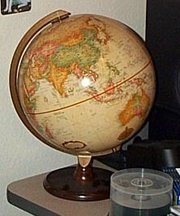Solar system model
|
|
Jupiter.SouthStation.agr.jpg
Mechanical models, called orrerys, that illustrate the relative positions and motions of the planets and moons in the solar system have been built for centuries. While they often showed relative sizes, these models were usually not built to scale. The enormous ratio of interplanetary distances to planetary diameters makes constructing a scale model of the solar system a challenging task. As one example of the difficulty, the distance between the Earth and the Sun is almost 12,000 times the diameter of the Earth.
If the smaller planets are to be easily visible to the naked eye, large outdoor spaces are generally necessary, as is some means for highlighting objects that might otherwise not be noticed from a distance. The objects in such models do not move. Traditional orreries often did move and some used clockworks to make the relative speeds of objects accurate. These can be thought of as being scaled in time instead of distance.
One scale model, designed to be easily replicated, is called The Thousand-Yard Model [1] (http://www.noao.edu/education/peppercorn/pcmain.html) and spans about a kilometre. In it, the Earth is represented by a peppercorn. A school class building this model might tape the peppercorn to an index card to make it more visible. Another scale model is the 1:10 000 000 model, in which 100,000 km is represented by 1 cm. In this model, the Sun is 600m from the Kuiper belt and planet Pluto.
Scale models in various locations
Several towns and institutions have built outdoor scale models of the solar system. Here is a table comparing these models.
| Location | Scale | Sun dia. | Earth dia. | Sun-Earth | Sun-Pluto |
| The Real Thing | 1:1 | 1.392 Gm | 12.76 Mm | 149.6 Gm | 5.914 Tm |
| Upstate New York from Syracuse, New York | 1:46,500,000 | 25.6 m | 305 mm (1 ft) | 3.5 km | 138 km |
| University of Maine at Presque Isle | 1:93,000,000 | 15 m | 140 mm? | 1.6 km | 64 km |
| Peoria, Illinois | 1:125,000,000 | 11 m | 100 mm | 1.2 km | 64 km |
| Boston Museum of Science | 1:400,000,000 | 3.5 m | 32 mm | 376 m | 14.9 km |
| York | 1:575,872,239 | 2.417 m | 22.1 mm | 259.73 m | 10.2679 km |
| Eugene, Oregon | 1:1,000,000,000 | 1.39 m | 12 mm | 150 m | 5.9 km |
| The Sagan Planet Walk (http://www.sciencenter.org/SaganPW/) | 1:5,000,000,000 | 278 mm | 2.5 mm | 30 m | 1.18 km |
| Jodrell Bank | 1:5,000,000,000? | 30 cm? | 2.5 mm? | 30 m? | 1 km? |
| The Thousand-Yard Model (http://www.noao.edu/education/peppercorn/pcmain.html) | 1:6,336,000,000 | 20.3 cm | 2 mm | 25 m | 983 m |
| Saint-Louis-du-Ha! Ha!, Quebec | 1:10,000,000,000 | 13.9 cm | 1.2 mm | 15 m | 590 m |
A model based on a classroom globe
Relating the size of the Solar system to familiar objects can make it easier for students to grasp the relative distances. Most classroom globes are 41 cm (16 inches) in diameter. If the Earth were reduced to this size, the Moon would be a 10 cm (4 inch) baseball floating 12 metres (40 feet) away. The Sun would be a beach ball 14 stories tall floating 5 kilometres (3 miles) away. Here is what a solar system built to that scale would look like. To our knowledge, the complete model has never been built.
| Body | Diameter | Distance from Sun |
| Sun | 44.6 m (146 ft) | zero |
| Mercury | 15 cm (6") | 1.9 km (1.2 mi) |
| Venus | 38 cm (15") | 3.5 km (2.2 mi) |
| Earth | 41 cm (16") | 4.8 km (3.0 mi) |
| Moon | 10 cm (4") | 12 m (40 ft) from Earth</i> |
| Mars | 23 cm (9") | 7.2 km (4.5 mi) |
| Jupiter | 4.55 m (15 ft) | 24.9 km (15.5 mi) |
| Saturn | 3.81 m (12 ft 6") | 45.5 km (28.3 mi) |
| Uranus | 1.63 m (5 ft 4") | 92.2 km (57.3 mi) |
| Neptune | 1.55 m (5 ft 1") | 144.4 km (89.7 mi) |
| Pluto | 7 cm (3") | 190 km (118 mi) |
| α Centauri A | 49.5 m (162 ft) | 1,323,500 km (822,400 mi) |

